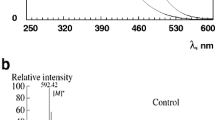Abstract
The eyes of a patient with canthaxanthin retinopathy were obtained at autopsy and examined by light and electron microscopy. Various tissues of one eye were also studied by physicochemical methods. Morphologically, there were red, birefringent, lipid-soluble crystals in the inner layers of the entire retina. They were particularly large and numerous perifoveally, where they were also clinically visible, but they also occurred frequently in a ring-shaped form peripherally and, less frequently, equatorially. The crystals were located in a spongy degeneration of the inner neuropil, where atrophy of the inner parts of the Müller cells was noticed. The compound isolated from the retina was identical with synthetic canthaxanthin according to mass and proton-resonance spectroscopy. Quantitatively, the retina contained up to 42 μg canthaxanthin per gram of tissue besides a minor amount of other carotenoids. Of the other tissues of the eye, only the ciliary body contained measurable concentrations of canthaxanthin. From the great number and size of the crystals, on the one hand, and the relatively small amount of isolated canthaxanthin on the other, it was concluded that the crystals presumably represent a canthaxanthin-lipoprotein complex rather than pure canthaxanthin alone. Examination showed that clinically, only the central portion of the canthaxanthin thesaurismosis, where crystals are packed most densely, can be seen.
Similar content being viewed by others
References
Bone RA, Landrum JT, Tarsis SL (1985) Preliminary identification of the human macular pigment. Vision Res 25:1531–1535
Boudreault G, Cortin P, Corriveau LA, Rousseau AP, Tardif Y, Malenfant M (1983) Le rétinopathie á la canthaxanthine. 1. Etude clinique de 51 consommateurs. Can J Ophthalmol 18:325–328
Cortin P, Corriveau LA, Rousseau AP, Tardif Y, Malenfant M, Boudreault G (1982) Maculopathie en paillettes d'or. Can J Ophthalmol 17:103–106
Cortin P, Boudreault G, Rousseau AP, Tardif Y, Malenfant M (1984) La rétinopathie á la canthaxanthine. 2. Facteurs prédisposants. Can J Ophthalmol 19:215–219
Daicker B (1978) Die fleckige fettige Degeneration der Netzhautperipherie. Eine Form der „Schneckenspuren“. Graefe's Arch Clin Exp Ophthalmol 205:147–155
Foos RY (1972) Vitreoretinal juncture, topographical variations. Invest Opthalmol 11: 801–809
Franco JL, Adenis JP, Mathon C, Lebraud P (1985) Un nouveau cas de maculopathie en paillettes d'or. Bull Soc Ophthalmol Fr 85:1035–1037
Hennekes R, Weber U, Küchle HJ (1985) Über Canthaxanthinschäden der Netzhaut. Z Prakt Augenheilkd 6:7–9
Jakobiec FA (1982) Ocular anatomy, embryology and teratology. Harper & Row, Philadelphia, p 490
Kaiser-Kupfer MI, Kupfer C, Rodrigues MM (1981) Tamoxifen retinopathy. Ophthalmology 88:83–89
McGuiness R, Beaumont P (1985) Gold dust retinopathy after the ingestion of canthaxanthin to produce skin-bronzing. Med J Aust 143:622–623
Metge P, Maudirac-Bonnefoy C, Bellaube P (1984) Thésaurismose rétinienne à la canthaxanthine. Bull Mem Soc Fr Ophtalmol 95:547–549
Meyer JJ, Bermond P, Pournaras C, Zoganas L (1985) Canthaxanthin. Langzeiteinnahme und Sehfunktionen beim Menschen. Dtsch Apoth Z 125:1053–1057
Philipp W (1985) Carotinoid-Einlagerungen in der Netzhaut. Klin Monatsbl Augenheilkd 187: 439–440
Poh-Fitzpatrick MB, Barbera LG (1984) Absence of crystalline retinopathy after long-term therapy with β-carotene. J Am Acad Dermatol 11:111–113
Puissant A (1984) La carotinodermie et la pilule à bronzer. Journée Ann Nutr Diet (Paris) 25:1–4
Ros AM, Leyon H, Wennersten G (1985) Crystalline retinopathy in patients taking an oral drug containing canthaxanthine. Photodermatology 2:183–185
Rousseau A (1983) Canthaxanthine deposits in the eye. J Am Acad Dermatol 8:123–124
Saraux H, Laroche L (1983) Maculopathie à papillottes d'or après absorption de canthaxanthine. Bull Soc Ophtalmol Fr 83:1273–1275
Tronnier H (1984) Zur Schutzwirkung von β-Carotin und Canthaxanthin gegen UV-Reaktionen der Haut. Z Hautkr 59:859–870
Weber U, Goerz G (1985) Augenschäden durch Carotinoid-Einnahme. Dtsch Ärztebl 82:181–182
Weber U, Goerz G (1986) Carotinoid-Retinopathie. III. Reversibilität. Klin Monatsbl Augenheilkd 188: 20–22
Weber U, Goerz G, Hennekes R (1985a) Carotinoid-Retinopathie. I. Morphologische und funktionelle Befunde. Klin Monatsbl Augenheilkd 186:351–354
Weber U, Hennekes R, Goerz G (1985b) Cartinoid-Retinopathie. II. Elektrophysiologische Befunde bei 23 Carotinoid-behandelten Patienten. Klin Monatsbl Augenheilkd 187:507–511
Author information
Authors and Affiliations
Rights and permissions
About this article
Cite this article
Daicker, B., Schiedt, K., Adnet, J.J. et al. Canthaxanthin retinopathy. Graefe's Arch Clin Exp Ophthalmol 225, 189–197 (1987). https://doi.org/10.1007/BF02175448
Received:
Accepted:
Issue Date:
DOI: https://doi.org/10.1007/BF02175448




